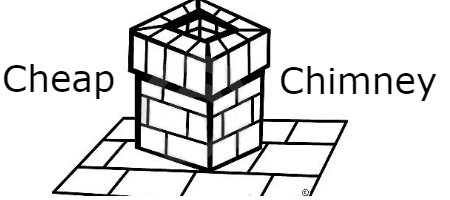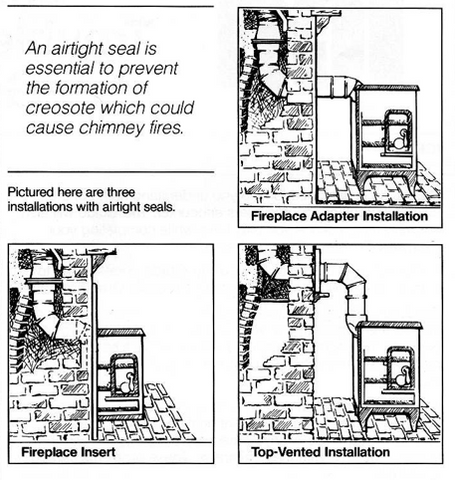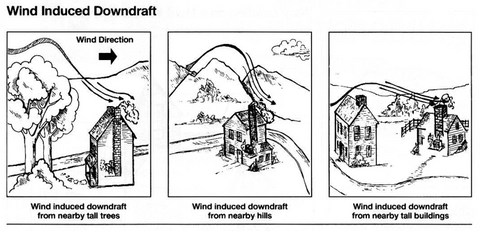Chimney Troubleshooting Guide
Basic Chimney Troubleshooting.
This guide is designed to help you understand some of the chimney problems homeowners encounter on a regular basis. If you look at the homes in your area, you'll notice that most have chimneys. Some are used to vent heating appliances, some to vent open fireplaces. Many homeowners experience performance problems with their chimneys. These problems can be remedied. Here at Cheap Chimney, we have been developing solutions to these problems for years. Lets look closely at the factors that affect a chimney's performance.
Types of Heating Appliances
There are four types of heating appliances: stove, furnace, fireplace, and fireplace insert. They can be fueled by wood, coal, gas, or oil. If more than one heating appliance is vented through the same flue, problems with draft will occur. Also, differences between the manufacturer's recommended stove pipe size and the actual size of pipe used for a wood or coal burning appliance can affect the stove's performance.
Types of Chimneys
Chimneys may be constructed from either masonry or metal. Both types require a tight seal between the heating appliance and the chimney. It is also important that the chimney is the correct size for the appliance.
Masonry chimneys can be built out of brick, stone, or cinderblock. These chimneys may be lined with a clay, firebrick, masonry, or metal liner. Chimneys in older homes may not be lined, or the lining may have completely deteriorated. Leaks along the length of the chimney can affect performance. An open or poorly fitting cleanout door at the base of the chimney can also adversely affect performance. Metal chimneys designed for use with heating systems are either Class A with solid insulation or multi-wall air-cooled. Single wall metal pipe chimneys may present a fire hazard if installed incorrectly. Class A chimneys have insulation between the flue and outer surface. Triple wall chimneys have two air-cooled channels between the flue and the outer wall. Recent innovations in triple wall chimneys feature insulation material in the inner channel and the outer channel is air-cooled.
The shape of the chimney and the effective area of the flue can affect performance as does the height of the chimney in relation to the peak of the main roof. Very specific problems are caused by short chimneys with respect to the overall height of the build, such as chimneys constructed on a one story addition to a multi-story building.
How Important is the Connection Between Stove and Chimney?
The dimension and the seal of the stove pipe to the chimney can also influence performance. Specifically, the pipe size, number of turns and length of the pipe can affect the draft.
Other Factors Affecting Performance
The location of the home with respect to hills, high trees or adjacent buildings can cause problems with downdrafts. Sometimes starting a fire or keeping one going can also be made more difficult in more modern, airtight homes. If the fireplace or stove cannot continually pull fresh air to burn you may need to investigate other venting options.
What are Some Common Chimney Problems?
Smoke flowing back into living areas rather than up and out the chimney can occur for a number of reasons.The backpuffing smoke signals that one or more factors may be adversely affecting chimney performance.
Wind induced downdraft
This is one cause of smoke backing up in the house. Wind induced downdraft is the downward flow of air into a chimney. It can be caused by the deflection of wind by obstacles higher than the chimney, such as neighboring tall trees, hills, and buildings. In this case there are many chimney caps available to deal with high wind to give you a solution to wind induced downdraft because it prevents wind from blowing into the chimney and allows the smoke to exhaust the chimney without interference. Check out our Vacu-Stack products for more info.
Dynamic wind loading
This wind feature can also contribute to backpuffing and smoke. Dynamic wind loading may occur in buildings when the wind causes negative inside air pressure. Negative air pressure and consequent tell-tale backpuffing may be particularly noticeable when a door or window is opened on a side of the building other than the windward side. To restore normal pressure in the building, make up air is apt to enter via the chimney and down into the living area. If the appliance is operating, smoke is then carried into the room.
This can be remedied by cracking open a window on the windward side of the house. The windward side being the side the wind strikes. Certain liner and cap solutions are also available for this problem.
Wind loading
Another common cause of smoke and backpuffing is wind loading on a multi-story building. As the wind flows against the second story vertical wall, a high pressure zone develops at the chimney top. Although a Vacu-Stack is not a guaranteed solution for this problem, it can definitely help. A chimney pot or extender is also another solution to gain more height and keep the chimney out of the high pressure zone.
Still Air
The occurrence of smoke and backpuffing when the air is calm is most likely caused by a number of structural factors that relate to the heating system. The chimney may be too short or the flue opening may be too large or small for the heating appliances. Smoke may also occur if the chimney is blocked with soot, creosote, or debris that has fallen into the chimney. If your chimney is not properly lined you will also experience draft issues.
In relatively air-tight houses, negative pressure problems can be caused by appliances that exhaust the inside air, such as cooking range exhaust fans, dryer vents, furnaces, and other devices. Your individual chimney problem may be the result of a variety of factors, but we're always here to help. We can work to identify your exact problem and outline the corrective actions to keep you safe and smoke free.




